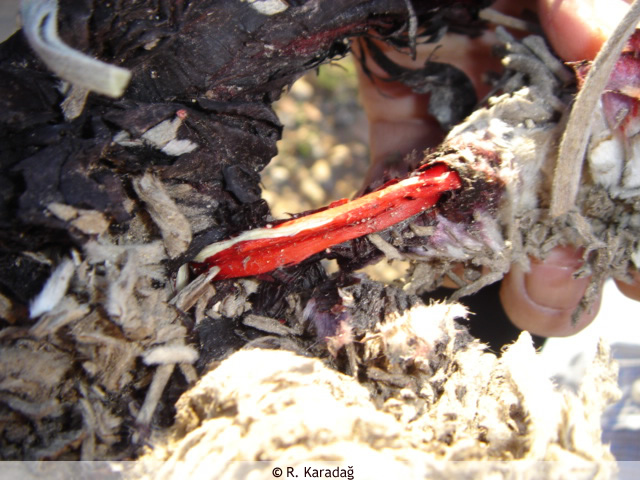The stems and leaves of this perennial dyeplant are covered with stiff hairs. The branching stems are 4 to 12 inches long and are semi-upright or lie on the ground. Its dark blue flowers grow in clusters. Distribution: Mediterranean area, on dry and sunny wasteland, often along the edges of roads. Material used for dyeing: Bark of the roots.
Historical Data
Dyer's alkanet has long been cultivated. The roots were used by the Romans to provide dyestuffs for fatty cosmetics and sweets, to give wines a darker colour, and often misused to adulterate or as a substitute for the true purple dye from snails.As a dyestuff for foods, alkanet was used until a few years ago, when the European Union banned it. Alkanet has also been used for a violet dye on silk, as discovered by a dye analysis of knitted silk from Central Asia . The story of the enantiomeric naphthoquinone natural products alkannin can be traced back many centuries. In fact, the story comprises two sub-plots that have run remarkably parallel courses in Europe and the Orient, being united only in the 20th century. In Europe , the S enantiomer, alkannin, is found in the roots of the plant Alkanna tinctoria Tausch, also known as Anchusa tinctoria , and in common English as alkanet. The compound is a major component of the deep red pigments that are easily extracted from the roots of the plant.It was probably the highly colored nature of alkannin that first captured the attention of botanists. Its use as a dyestuff for fabrics almost certainly dates back centuries BC. Perhaps the first recorded use of Alkanna tinctoria roots is found in the works of the Greek doctor and philosopher Hippocrates (4th and 5th centuries BC) who described their use for the treatment of ulcers. The botanist and scholar Theophrastus (3rd and 4th centuries BC) also alluded to their application as dyes and medicines. Alexander the Great was known to have employed doctors trained in herbal medicine, and it thus seems likely that the medicinal properties of Alkanna tinctoria root were used to treat the sick and injured during his campaigns.Pliny, a Roman herbalist contemporary with Dioscorides, independently made very similar claims for the medicinal properties of Alkanna tinctoria : It stains the hands the colour of blood; it is used for imparting rich colours to wool. Applied with cerate it heals ulcerous sores, those of the aged in particular: it is employed also for the cure of burns. These are notably the medicinal properties claimed independently for Alkanna tinctoria in many of the ancient herbal texts. In Europe and North America , Alkanna tinctoria is mainly used today as a pigment for food coloring and cosmetics.

